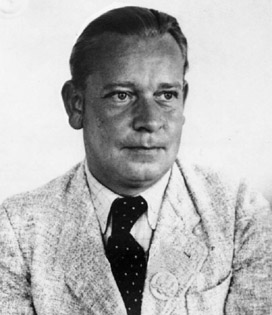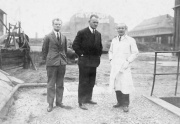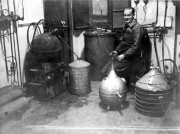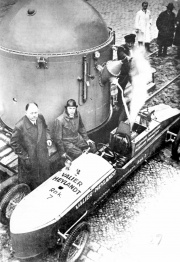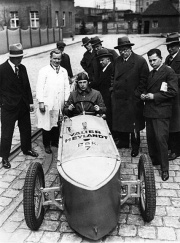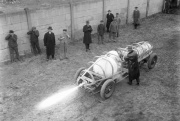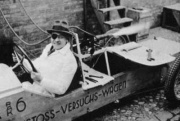Walter J.H. Riedel
From The Space Library
Contents |
Early Life
Walter Julius Hermann "Papa" Riedel was born in 1902 in Königswusterhausen, near Berlin Germany. His parents were Julius Wilhelm and Margarete Emma Riedel. From 1921 - 1927 he was employed as a civil engineer working for Bamag and at Wolf, Netter and Jacobi.
Heylandt and Valier
In 1927 he joined the A.G. Fuer Industriegasverwertung as a designer and engineer. He was assigned by his boss, Paul Heylandt, to be an assistant to the early rocket pioneer Max Valier, a role which he took from January 1930 until Valier's death in May 1930.
During those few months Riedel worked side by side with Valier as they created ever more powerful liquid fuel rocket engines. Over a four day period at the end of January 1930 Valier's engine increased in thrust from 300gm to 2,150gm. After a brief interlude Valier and Riedel increased the thrust in March 1930 to 8,000gm. On March 22nd 1930 the engine was installed in Valier's experimental rocket car the Rak 6, which was renamed the Rak 7. Valier was able to drive the car around a track for 22 minutes. In April they were joined in their efforts by a young engineer named Arthur Rudolph. By April 14th the engine was putting out 28kg thrust. The car was put around a test track for nearly 10 minutes and Riedel later wrote, "April 17 and 19 1930...These dates should be noted because they are of some historic importance. Indeed, it was the first time that a rocket propulsion with liquid propellants was demonstrated in Germany..."
On May 17th 1930 Riedel was operating the valves on an engine test using kerosene instead of alcohol as the fuel. Despite an earlier problem with the engine, Valier pushed ahead with another test against the protests of Riedel. The kerosene and liquid oxygen created a slurry in the engine nozzle and when the gelatinous mixture fell into the exhaust plume the engine exploded. Valier was mortally wounded and Riedel could do nothing more than catch him as he fell. Riedel was only six feet away from Valier and was partly protected by a low wall. Valier's death was the first high-profile accident involving a fatality with a liquid fuel rocket.
Work continued with Riedel, Heylandt and Arthur Rudolph at the Heylandt factory in Berlin-Britz after Valier's death. A larger car was built and tested at Tempelhof airport. It had a cylindrical fuel tank at front, a small nitrogen pressurisation system and a large spherical oxygen tank in rear. Rudolph later stated that Riedel "designed the entire system of the rocket car, I was responsible for the new injection system."
In 1931 or 1932 Riedel and Rudolph proposed and then built sophisticated cooling systems for their rocket engine, first using a water "jacket" and then regeneratively cycling the fuel around the combustion chamber.
Riedel may have briefly become a member of the VfR but the VfR and Valier's team didn't share common goals for very long. Valier was mostly interested in demonstrating rocket propulsion to the public by building rocket cars, planes and even sleds, using any kind of rocket including black powder or pressurised carbon dioxide. It was only in early 1930 that Valier turned to liquid propellants and it was Riedel who showed him the way forward.
Peterson reports that in March 1933 Riedel voted for the National Socialist Party.[1] This would have been within a few weeks of the Heylandt company being given a contract by the German Army to build a sophisticated liquid fuel rocket system with instrumentation, steady thrust and automatic valves. Riedel completed this project by the end of 1933 and fulfilled all of the Army's specific requests.
Kummersdorf
In 1934 long after the death of Valier, Riedel and Arthur Rudolph were still increasing the thrust from their liquid rockets when Walter Dornberger head of the German Army's rocket division recruited Riedel to come and join Wernher von Braun at Kummersdorf. He transferred from the Heylandt Company to Kummersdorf on January 15th 1934.[2] For a short time the entire German Army rocket team was comprised of just three men, Von Braun, Papa Riedel and a mechanic named Heinz Grünow.
When Riedel first arrived at Kummersdorf Von Braun had spent a year building his own liquid fuelled rocket but whereas Riedel had been building his system to run on a test stand, Von Braun was building a rocket to fly. This first iteration of Von Braun's design was known as the A-1. The ignition system was unreliable and the A-1 exploded multiple times. Von Braun and Riedel turned to a new design which incorporated many of the fuel tank, pressurization, valve and ignition systems designed by Riedel at Heylandt. The Army apparently paid for much of this technology to be transferred to Kummersdorf. This hybrid of Riedel and Von Braun components became known as the A-3 and with some further modification, the A-5, a missile which was essentially a highly successful miniature testbed version of the V-2.
In 1936 Von Braun had the idea to create a rocket propulsion system for a small aircraft. The requirement for this system was a hydrogen peroxide powered turbo-pump to push the propellants into the combustion chamber. Although it never flew, it gave both Von Braun and Riedel experience with HTP turbo pumps which Riedel later cited as proof that Max Valier had been correct to work on rockets for aircraft.
Peenemünde and the V-2
In 1937 Riedel became chief designer of the V-2 missile. In October 1942 he became Chief engineer on the V-2 production. In this role he was to fall prey to a political struggle between Dornberger and Von Braun. The former was becoming frustrated with the slow pace of development and propulsion engineer Walter Thiel blamed Riedel's department. Von Braun moved Riedel aside and by the summer of 1943 he was made special assistant to Von Braun in charge of monitoring production timelines for the V-2.[3] After the bombing of Peenemunde, when Thiel was killed, another role was found for Riedel; he was sent to survey a potential location for an underground construction site for rockets near Ebensee in Austria. Peterson also reports that Riedel "temporarily transferred there to assist in the work." According to other reports he was only at Ebensee from October 1943 until February 1944. The site later became a notorious concentration camp where military hardware was constructed, but no rockets came from Ebensee. For most of the rest of 1944 he was in Bad Sachsa and Schwedt. Up until the end of the war he was working as a government building surveyor.
Post War Capture
"Papa" Riedel was frequently mixed up by later writers with Walther Riedel, another rocket pioneer who was captured in Saalfeld and who had also worked on the V-2 before moving to California to work for North American Aviation.[4] Walter "Papa" Riedel seems to have been captured by American Intelligence operatives in the area of Alt Aussee in Austria. He was caught up in a dragnet operation being run by Robert E. Matteson of the US Third Army counter intelligence. Matteson was in pursuit of the infamous Ernst Kaltenbrunner who he had traced to the so-called "National Redoubt" which was a semi-mythical fall-back position in the Austrian Alps at Alt Ausee. Many prominent figures in the Nazi regime had been led to believe that Alt Aussee would be a safe refuge from the advancing allied forces. When Matteson arrived there in May 1945 he found nothing to defend the area beyond a few tank traps. He did discover an assortment of refugees including "provincial governors, ambassadors, artists musicians and nobility". Riedel was captured on 29 May 1945 and held at Deggendorf until 20 September 1945. Matteson later referred to Riedel as one of a "group of lesser Nazis who had fled to Alt Aussee, seeking for the most part time to collect their thoughts and prepare their anti-Nazi alibis."[5] Evidently US Army intelligence then interrogated Riedel at Alt Aussee.
Some reports also claim that "Papa" Riedel was interrogated in the United States at the end of the war. There is no evidence of this in the US immigration records which document most of the other Germans brought to the USA under Project Paperclip. Presumably he was found to be clear of any war crimes since he was swiftly handed over to the British who immediately put him to work.
After working from 1 November 1945 to 10 March 1946 as senior research and development manager for British V-2 rocket launches at Cuxhaven, as part of Project Backfire, "Papa" briefly then worked from 11 March to 31 July 1946 at Eugen Sanger's Raketentechnisches Forschungsinstitut in Trauen.
Employment in England
In March 1947 Papa Riedel was offered employment at the Royal Aircraft Establishment at Farnborough England where he worked until moving over to the associated Rocket Propulsion Establishment at Westcott in Buckinghamshire in 1948. The same year he was listed as a Fellow of the British Interplanetary Society, living at a Ministry Hostel in Bicester. He was granted British citizenship on November 18th 1953 and was sworn in on 30th November with an oath of allegiance to Queen Elizabeth II. His occupation was listed as "Temporary Civil Servant". He and his wife Else and their daughter were living in Aylesbury, Buckinghamshire at this time.
Late Life and Legacy
Riedel remained working at Westcott until his death which happened while visiting his sister in East Berlin on May 15th 1968. At that time his home was in the town of Tring in Hertfordshire. His will says he died with an estate worth £10,234. In his obituary in the Journal of the British Interplanetary Society it was reported that he had worked on both liquid and solid fuel rockets at Westcott. It is known for certain that he wrote a damage analysis for the British solid fuel Cuckoo II rocket engine when it was being used as a second stage for the Black Knight rocket.
In 1953 he wrote of his experiences with Valier in an article for the journal Weltraumfahrt.
In 1956 writing in the Journal of the British Interplanetary Society Wernher von Braun stated, "Hardly a rivet or washer in our experimental A-3, A-5, A-9, and particularly the A-4 can have escaped his personal scrutiny."[6]
A technical study of Riedel's work from 1930 to 1942 was translated into English in 2005 and published by the Rolls Royce Historical Society.[7] In that document Riedel explained how many of the principle components of the A-3 propulsion system came from the research he had conducted with Valier, and remained virtually unchanged when applied to the V-2. This contention was supported by later research conducted in 2007 by Dr Olaf Przybilski at the Dresden Technical University.[8]
In a letter written just before his death he stated, "For personal reasons I have severed my connections related to rocket and space exploration. I also do not wish to be mentioned in any way with the beginnings of the missile"[9]
Footnotes
- ^ Engineering Consent: Peenemunde, National Socialism, And The V-2 Missile - Michael Brian Petersen (2005)
- ^ Wernher von Braun's Aggregat 2 - Olaf Przybilski (Luft- und Raumfahrt 3/2007)
- ^ Von Braun - Dreamer of Space, Michael J. Neufeld (Knopf 2007)
- ^ The Rocket Team - Frederick I. Ordway III and Mitchell Sharpe (Apogee 2003)
- ^ The Last Days of Ernst Kaltenbrunner, CIA HISTORICAL REVIEW PROGRAM 22 SEPT 93
- ^ Reminiscences of German Rocketry - Wernher von Braun - JBIS Vol 15 No 3 May-June 1956
- ^ Rocket Developments With Liquid Propellants - W.H.J. Riedel (Rolls Royce Heritage Trust TS07 2005)
- ^ Wernher von Braun's Aggregat 2 - Olaf Przybilski (Luft- und Raumfahrt 3/2007)
- ^ Ibid.
